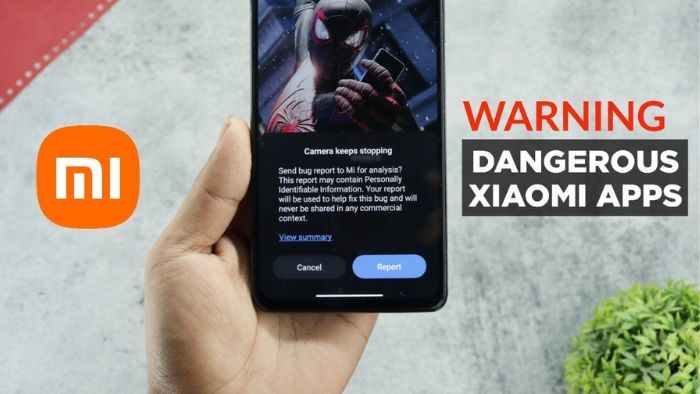In the constantly evolving landscape of smartphone technology, the security vulnerabilities in Xiaomi smartphones have become a pressing concern for users worldwide. With the increasing reliance on smartphones for various tasks, understanding the risks associated with these vulnerabilities is crucial. Xiaomi, a prominent player in the tech industry, has been actively responding to these security challenges to ensure the safety and privacy of its users. By delving into the details of Xiaomi smartphone security vulnerabilities, we can gain valuable insights into the potential risks involved and the measures taken by Xiaomi to mitigate these issues.

Security Vulnerabilities in Xiaomi Smartphones
Following a recent discovery, 20 dangerous applications have been identified in the latest Xiaomi smartphones. These vulnerabilities pose severe risks, potentially leading to the leakage of sensitive user information and unauthorized remote device control.
The security flaws have a notable impact on the MIUI and HyperOS systems, raising concerns about the overall safety and privacy of Xiaomi smartphone users. Key applications such as Gallery, Mi Video, and Settings are among those affected, highlighting the widespread nature of the issue.
These security vulnerabilities have their origin in Xiaomi’s patching of AOSP applications. While intended to enhance functionality, these modifications inadvertently created loopholes that malicious actors could exploit for unauthorized access and data breaches.
Addressing these security concerns is paramount, emphasizing the critical need for continuous monitoring, timely patches, and user vigilance when it comes to safeguarding personal data on Xiaomi smartphones. Such incidents underscore the importance of robust security practices in tech companies to mitigate risks and protect user privacy effectively.

List of Vulnerable Applications
Security vulnerabilities in Xiaomi smartphone applications pose significant risks to users. Vulnerable apps like Gallery (com.miui.gallery) and Mi Video (com.miui.videoplayer) could be entry points for exploits. Additionally, GetApps (com.xiaomi.mipicks) and ShareMe (com.xiaomi.midrop) may expose user data to potential threats.
Moreover, critical components like MIUI Bluetooth (com.xiaomi.bluetooth) and Security Core Component (com.miui.securitycore) could be exploited for unauthorized access, emphasizing the need for robust security measures. Xiaomi’s proactive approaches towards securing apps like Phone Services (com.android.phone) and Settings (com.android.settings) are essential for safeguarding user privacy and data integrity.
Furthermore, addressing vulnerabilities in apps such as Print Spooler (com.android.printspooler) and System Tracing (com.android.traceur) is crucial to prevent potential breaches. By enhancing security protocols in applications like Security (com.miui.securitycenter) and Xiaomi Cloud (com.miui.cloudservice), Xiaomi aims to bolster user trust and ensure a safe digital experience for Xiaomi smartphone users.

Xiaomi’s Response to Vulnerabilities
Xiaomi addresses smartphone security vulnerabilities by releasing timely updates to patch significant issues. This proactive approach not only safeguards user data but also enhances device security. Users can trust Xiaomi’s commitment to promptly addressing security concerns, reflecting a dedication to ensuring the safety and integrity of their devices.
By consistently demonstrating a proactive stance on security, Xiaomi showcases its dedication to protecting user data and privacy. This approach underscores the company’s understanding of the evolving nature of cyber threats and the importance of staying ahead in safeguarding against potential vulnerabilities in Xiaomi smartphones.

Essential Security Practices
In addressing Xiaomi smartphone security vulnerabilities, regular security checks play a crucial role. By conducting consistent assessments, potential weaknesses can be identified and rectified promptly, enhancing the overall security posture of Xiaomi devices.
Timely patching of software vulnerabilities is paramount in mitigating risks associated with Xiaomi smartphone security vulnerabilities. By swiftly addressing identified weaknesses through patches and updates, Xiaomi can effectively protect its users from potential cyber threats and breaches.
Transparent communication with users regarding security updates is key in fostering trust and accountability. By openly sharing information about security vulnerabilities and the actions taken to address them, Xiaomi demonstrates a commitment to user safety and promotes a culture of transparency in the tech industry.
The importance of these actions for tech companies like Xiaomi cannot be overstated. By prioritizing regular security checks, timely patching, and transparent communication, Xiaomi not only safeguards its users but also sets a standard for proactive security measures within the tech industry, promoting a safer digital environment for all consumers.
